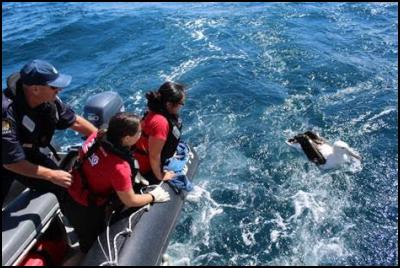Nationally vulnerable Albatross returns to the wild
Nationally vulnerable Albatross returns to the wild

A nationally vulnerable Toroa Northern Royal Albatross that was receiving care at Wellington Zoo has been released back to the wild with help from the Maritime Unit of the Wellington District Police.
After arriving with a very low body condition and a deep injury to its left eye, the Toroa was nursed back to health by Wellington Zoo’s Veterinary Team at The Nest Te Kōhanga.
“While the bird was in a pretty bad way when it arrived, we’ve been able to get it fit to return to the wild,” says Amanda Tiffin, Veterinary Practice Manager at The Nest Te Kōhanga. “The injured eye was too damaged to recover, so it was removed during a procedure to prevent the risk of infection. The bird recovered well from eye surgery and has gained weight and strength, so we’re glad to be able to release it back to the wild.”
There are reports of one-eyed Albatross hunting, foraging, and breeding in the wild – so the outlook is positive for this Toroa. When it came time to return it to the wild, Maritime Police stepped in to provide a lift, as Toroa usually need a long run up on the water in order to take to the air.
“Returning the Toroa back to the wild is an important step for conservation efforts to save the species, which is classified as nationally vulnerable by DOC,” said Tiffin. “Saving native wildlife is a crucial part of the work we do at The Nest Te Kōhanga, and returning native animals to the wild makes an important contribution to Wellington Zoo’s conservation work.”
“We’re grateful to the Maritime Unit for helping us get this bird out to sea so it can make its way back to the wild,” said Tiffin. “Working with the Department of Conservation and the Wellington District Police to get this bird back to the wild highlights the collaborative nature of conservation work.”
Toroa only breed in New Zealand waters, and they usually mate for life even after long separations at sea.
“If this Toroa already has a mate, they return to the same nesting area each time they breed, so we’re hopeful it will be able to find its mate again.”
About Toroa Northern Royal Albatross
Toroa usually range throughout the Southern Ocean, and are seen in New Zealand’s coastal waters during winter. They are very rarely seen in Wellington as their nesting sites are on the Chatham Islands and at Taiaroa Head on the Otago Peninsula.
Along with the Wandering Albatross, Toroa are the largest seabirds in the world and are renowned for travelling great distances from their breeding grounds to feed – up to 190,000km a year.
ends


 Gordon Campbell: On The Public Sector Carnage, And Misogyny As Terrorism
Gordon Campbell: On The Public Sector Carnage, And Misogyny As Terrorism DoC: Canterbury Spotted Skink In Serious Trouble
DoC: Canterbury Spotted Skink In Serious Trouble Te Pāti Māori: Oranga Tamariki Cuts Commit Tamariki To State Abuse
Te Pāti Māori: Oranga Tamariki Cuts Commit Tamariki To State Abuse NZCTU: Inflation Data Shows Need For A Plan On Climate And Population
NZCTU: Inflation Data Shows Need For A Plan On Climate And Population Statistics New Zealand: Annual Inflation At 4.0 Percent
Statistics New Zealand: Annual Inflation At 4.0 Percent Brendon McMahon - Local Democracy Reporter: West Coast Swim Spot Testing Clear Of E-coli
Brendon McMahon - Local Democracy Reporter: West Coast Swim Spot Testing Clear Of E-coli Green Party: Government Throws Coal On The Climate Crisis Fire
Green Party: Government Throws Coal On The Climate Crisis Fire


